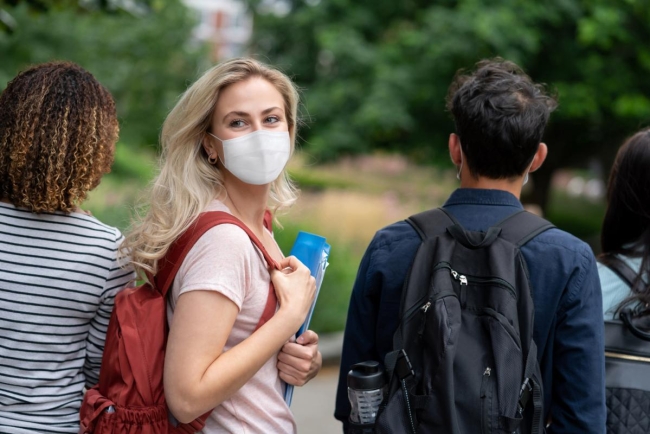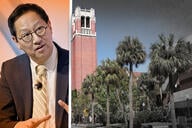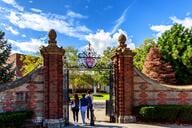You have /5 articles left.
Sign up for a free account or log in.

andresr/E+/Getty
Students returned to High Point University this fall just after the local board of commissioners reinstated the indoor mask mandate. Had the direction of the pandemic taken a bad turn, students wondered?
In-person classes dominated the 2020–21 academic year at High Point—when courses at so many other campuses across the U.S. were fully remote or hybrid. Yet Joseph Maronski, currently a junior journalism and political science major, says it was still a tense time. “Over the spring everybody was always thinking about COVID. Would you get quarantined? Or you’d get a text in the middle of class to learn a friend or family member got COVID.”
Now, with vaccines working and solid treatments known, such news is less frightening. In fact, early this November during a class, Maronski missed a call from his mom, and when he reached her later, she shared her COVID-positive status. “She got diagnosed one day and got antibody treatment the next day,” he says. “It was definitely nerve-racking, but not as nerve-racking as if she had gotten it last year.” (With Mom recovered, he and his brother, a college freshman, enjoyed Thanksgiving at home on Long Island with the family.)
High Point, in North Carolina, has been like many other higher ed institutions this fall in that campus organizations could host events, invite external guests and engage in conference and other travels. There’s some stress, yet it’s not constant, Maronski says, adding that his a cappella group expects to perform in Disney Springs in Orlando, Fla., in January (traveling with negative-COVID confirmation). “Everybody has those days. But I feel like last year, every day was one of those days.”
In the latest Student Voice survey, conducted Nov. 15 to 23 (before the Omicron variant news exploded), more of the 2,000 student respondents reported the semester was going better than expected (34 percent) than that it was going worse (22 percent).
Better in what ways? The top reasons cited include in-person classes, social opportunities and professors’ understanding of student challenges. (With three-quarters of the 250 two-year students surveyed still learning fully or partially online, they were about half as likely as their four-year peers to cite the success of in-person classes, as well as twice as likely to note online classes going better than expected.)
Other highlights from the Inside Higher Ed and College Pulse survey, supported by Kaplan:
- One-third of students (and nearly half of private nonprofit college students) feel their institution was very prepared for the wide return of in-person learning this fall, with an additional half of the full sample believing their institution was somewhat prepared.
- More than half have felt safe from COVID on campus, while one in five believes continued COVID mitigation measures have not been necessary. Split by political leaning, 42 percent of Republicans think the measures have not been necessary, compared to 11 percent of Democrats.
- Six in 10 students have socialized this semester either more than ever before or more than in the spring.
- Thirty-five percent assess their mental health as better than it was during the spring, although 60 percent are still struggling, rating their mental health this semester as fair or poor.
- Forty-six percent of students rate the value of the education received this fall as very good or excellent. (In a late-May Student Voice survey, only about one-quarter of respondents rated that academic year’s education as very good or excellent.)
Student assessments of the fall semester, as well as their input about supports they’ll need more of in the spring, provide a pulse for how colleges are doing and what they can continue to strive for.
The Return
Most institutions were opening campuses more fully this academic year, despite growing concern about the Delta variant. Six in 10 students surveyed recall feeling at least somewhat stressed about the uncertainty of returning.
Sixty percent also represents how many students have received some form of emergency grant aid to help in even getting to or paying for this academic year.
Was it a huge help? The National Association of College Stores surveyed students in summer 2021 about various types of financial assistance received, with more than half saying the funds did not help at all (about one in four said they helped at least moderately). These findings are an indication that students had lingering financial pressures packed in their suitcases for their fall 2021 return.
Looking at the Student Voice survey results about expectations for the fall semester, NACS’ Brittany Conley, research analyst for the OnCampus Research division, wonders how low their expectations were. Did those who say the semester went better than expected truly have a good semester?
Student Voice survey respondents generally acknowledged institutional efforts to get the fall semester right, with 84 percent saying their college was at least somewhat prepared for the return of in-person learning.
Community college students were more likely to select “very prepared” and less likely to select “not too prepared” or “not at all prepared,” which President Joseph Schaffer of Laramie County Community College in Wyoming attributes to student characteristics rather than institutional actions. “Our students are purpose-driven, they’re focused, and they understand how to navigate the complexities of life,” says Schaffer, also chair-elect on the 2021-22 American Association of Community College Board of Directors. “They’re motivated.”
When it comes to course experiences this fall, more than two-thirds of students felt professors seemed glad to be back on campus. At Laramie, a guided-pathways school, faculty generally have strong interactions with students. “Professors who choose to work at a community college relish the opportunity to make deep relationships with students,” says Schaffer. “Our faculty are incredibly excited to be back in the classroom.”
While a president can’t speak for every professor, that perspective does challenge the perception of faculty members being upset about needing to come back in person and feeling safer with the idea of remote instruction.
As noted, most students felt safe from COVID on campus this fall. Republican-leaning students were about 10 percentage points more likely to have felt safe compared to Democratic-leaning students. Only 15 percent of the full sample felt vulnerable to the virus because their institution’s mitigation actions or policies weren’t strong enough.
Among students who felt continued COVID mitigation measures this fall weren’t necessary, how was compliance? In Schaffer’s experience at an institution with a 60 percent employee vaccination rate and student vaccination rates not being tracked—and where face masks and social distancing are encouraged for students rather than mandated—the campus community is still doing what they can as individuals to “protect ourselves and protect our neighbors.” The need for resiliency to roll with pandemic punches, he adds, embodies what a community college student has to do, pandemic or not.
Scripps College’s efforts to contain COVID this fall went better than expected, says Gretchen Edwalds-Gilbert, acting vice president for academic affairs and dean of faculty at the institution. Anxiety was rampant as the semester began, “with people waiting for the other shoe to drop,” she says. This was in spite of Scripps following Los Angeles County’s strict public health guidelines, a vaccine mandate and weekly COVID testing for students and employees.
The college, a member of the Claremont Colleges consortium, stretched out time between classes this fall by a few minutes to help students adjust to being back and needing to get from point A to B rather than just navigating to another Zoom room.
A more involved move was setting up nine technology-equipped tented outdoor classrooms with ADA-accessible three-layer flooring on part of the athletic field. “We’re the envy of neighbors here in Claremont,” says Edwalds-Gilbert. “Back in April people were saying, ‘Gosh, maybe Scripps put their money in the wrong place.’ In August we looked like geniuses.”
Fifty-five percent of Student Voice survey respondents’ institutions have mandated vaccines for both students and employees, with that group of students being about equally likely as students over all to feel COVID mitigation measures have not been necessary.
At High Point, where Maronski estimates about three-quarters of students haven’t really worn masks since the county mandate was lifted in November, measures such as COVID testing prior to events like his choir concerts are working, he says. “We had a single positive case the other day.”
The Transition
[block:block=176]
Students’ ability to adjust to college life this fall varied in part based on their year in college. Edwalds-Gilbert noticed a lot of students describing “being rusty about how to engage with people in person,” with first- and second-year students seeming more tired. Scripps sophomores apply in the fall for study abroad the following fall, with participation typically over 60 percent, but applications indicate next fall will see a big dip. She’s not surprised to have heard sophomores express the sentiment “I just got here and I’m not ready to leave again. I missed enough.”
Freshman enthusiasm was evident to Amber Williams, vice provost for student success at the University of Tennessee, Knoxville, in orientation event data. “Our orientation process is six weeks, with about 600 events during that period”; one large event drew “5,100 students dancing and engaging” (out of 5,800 first-time, full-time freshmen and 7,175 total full-time freshmen).
A six-week reorientation for sophomores and juniors also drew strong participation, about 4,300 students (approximately half of the full-time enrollment for these classes), reports Williams.
At Scripps, which didn’t begin opening up to in-person classes until the end of the spring semester, seniors seemed to embrace this fall the most, says Edwalds-Gilbert.
The Student Voice survey provides strong evidence that campuses have become social places again. One-third of surveyed students are socializing more than in the spring but not as much as pre-COVID, and nearly an additional one-third are socializing more than ever before. An equal number are advocating for causes of meaning to them either more than in the spring but less than pre-COVID, or more than ever before.
“We were all hungry to get back into everyday life and continue some sense of normalcy that we missed over COVID, but I wasn’t sure how long it would take for that to return,” wrote one survey respondent from a public university in California. “It has been far more fun than I expected.”
Maronski can’t think of a single club at High Point that still meets virtually. “Once in a while you have a virtual speaker, but everyone is meeting and hanging out in person,” he says. Officials even added little igloos with seating throughout campus to give small groups a fun place to gather.
As survey time, student respondents were clearly still feeling fatigued about the pandemic. Self-reports on physical health remain almost identical to a spring 2021 Student Voice survey, with about two-thirds saying it’s excellent or good and about one-third rating it as fair or poor.
On the mental wellness front, students “had to get back to the rhythm of being on campus and juggling in-person commitments,” says Jenny Darroch, dean of the business school at Miami University of Ohio. Yet they, and professors, were excited to be there. “You can almost feel the celebration in the air,” she said of this semester. “We are social creatures, and wanting people around is an important part of who we are.” Darroch has noticed students being choosy about what cocurricular events they attend, however.
Meeting students’ basic needs, a challenge with or without the pandemic, is another stressor getting attention during this time, says Amy Gatto, senior manager for higher education and evaluation at Active Minds, which supports mental health awareness and education for young adults. Social justice, health equity and discrimination issues are other continuing student stressors.
While many Student Voice respondents rate their current mental health status as better than it was in the spring, one-quarter say it’s now worse. The six in 10 who say their mental health is fair or poor is just slightly better than the 65 percent saying that in the March 2021 Student Voice survey on mental health.
“Any time we talk about mental health during the pandemic, it’s important to remember that both prevalence and severity of mental health needs on campus were already on the rise,” says Gatto. But the recent renewed attention on the issue has presented awareness-building opportunities.
At High Point, this has happened increasingly, Maronski says. A weeklong student government campaign focused on mental health awareness and suicide prevention wound up being a literal lifesaver. “Somebody reached out and said they had been on the verge of taking their own life and finally felt they could go to counseling because of this push,” he says.
One step in supporting a struggling student is to validate feelings. “A benefit of the pandemic is that a lot of people understand loneliness and stress,” Gatto says. “No matter where you are on the spectrum, there’s some relatability.”
And while faculty members can be hesitant talking to students about mental health for fear they will say or do something wrong, such conversations can help determine referrals to make. Educators can mull over these questions, adds Gatto: “Is it really a time management issue and they need to talk to an academic adviser? Do they need to be referred to a counselor?”
Campus leaders should consider whether counseling center policies may be scaring off students who might otherwise make an appointment. An Active Minds analysis of one counseling center’s utilization found a potential issue—a hard stop on the number of visits allowed per person, with a big sign announcing that limit. “Most students were nowhere close to it, but the perception was, ‘If I go, I won’t be able to finish my treatment there.’ We removed that number and saw an increase in student utilization of the counseling center,” Gatto says.
At institutions without a counseling center (a fair number, Gatto says), counseling referrals must be made to resources in the community instead.
In a November Barnes & Noble Education survey of 1,116 college students, the No. 1 nonacademic stressor noted was the pandemic and if it will ever end, and “getting good grades” got the highest ranking among academic stressors.
A question about stress levels in UT Knoxville’s November pulse survey of freshmen found 86 percent have a “manageable level” of stress, Williams says (had the survey been conducted just before finals, she adds, that percentage would have been lower). In addition, 92 percent believe they can excel academically, a stat Williams attributes to every first-year student having a three-person success team and to tutoring services being branded as something successful students seek.
An exercise in the first-year seminar Williams taught this semester gave her a closer look at academic challenges this fall. She asked students to take notes as they watched footage of a faculty member lecturing on an unfamiliar topic. “You should’ve seen their faces,” she says. When they described how overwhelmed and unprepared they felt, she pointed this out as a reason students must show up to a class having read the material already. “We kind of had to teach them what it means to be a student in person, how to engage in the classroom, being an active learner and active participant,” she says.
At Scripps this fall, even students in advanced science classes had to be retaught the basics of using lab equipment, says Edwalds-Gilbert. And professors in all disciplines found themselves needing to articulate expectations for group work and engaging students in discussion about expectations for individuals in a group.
Professional academic advisers at Miami University who track attendance and grades to see who needs intervention stepped up efforts. “This semester, they were more vigilant about watching that data and engaging in earlier interventions than in pre-COVID years,” says Darroch, adding that there has indeed been an increase in the need for academic intervention. “Grades aren’t as high as some of the faculty hoped they would be.”
The Reflection
Do students feel they got their tuition money’s worth? Nearly half would rate the value of the education received this fall as very good or excellent, with community college students more likely than four-year college students to give one of those responses (65 percent compared to 43 percent).
The late-May Student Voice survey with the same question, which, as noted, revealed that only one-quarter of students would say last year’s education was very good or excellent, found community college students to be less harsh. Nearly four in 10 community college students gave those ratings.
Schaffer surmises that the community college students surveyed this fall may be more likely on direct vocational tracks as opposed to students in general education studies who may “struggle to see that value proposition.” Laramie’s strongest enrollments are in programs on the applied learning side, he adds.
Conley, from NACS, guesses that community college students may also see more value in their education because they’re paying much less for it than their four-year counterparts. “I’m paying only $3,000, so I have $3,000 expectations,” they may think.
Students reflected on their needs for spring 2022. In selecting up to two items from a list of possible supports, the full survey sample called most for more access to counselors or therapists. That’s especially a need for LGBTQIA+ students (with 37 percent selecting that item compared to 19 percent of straight-identified students). Democratic students are another standout group looking for more counseling—29 percent compared to 12 percent of Republicans.
Gatto from Active Minds isn’t surprised students are calling for more counseling but wonders what more access would look like. “Do they want counselors embedded in places they go? Longer hours for the counseling center? Telehealth? Better connections to community resources? This is a place to dig deeper on campus,” she says, “to ask students, ‘What does this mean for you?’”
Yet limitations continue to exist for campus counseling—institutional barriers, funding, time allocation and counselors in the pipeline, to name a few, she says. She suggests bringing in speakers for health and wellness talks who can help “normalize the conversation of mental health on campus.” In addition, professors can embed mental wellness into syllabus statements and break for mindfulness moments or meditation in the classroom. Gatto would also like to see actions for supporting student mental health in institutional strategic plans.
Community college students seek more access to counseling, but it’s their second most popular support need, with the ability to take more courses online as their No. 1 need for 2022. At Laramie, Schaffer says the mix of in-person and online delivery is currently at about 50-50 and that older students generally call for more in-person activity. Last spring about 75 percent of courses met online only, with asynchronous delivery as the most common model. This year, he says, the institution has shifted its online courses more toward synchronous. HyFlex models in some programs allow individuals to make a daily choice about attending class on campus or virtually—an option about one in five students would like but many higher ed institutions would find it very challenging to offer.
UT Knoxville officials have chosen to be proactive about spring semester student success by having influential alumni and academic coaches engage with students during winter break via emails, postcards and direct outreach. Students will be asked to develop an academic new year’s resolution and think about their goals and dreams even while enjoying family time, says Williams. The overarching message from the university, she adds, is this: don’t forget about us.
As Williams heads into her own (shorter) break, she will be reminding herself of how her personal well-being impacts faculty, staff and students. “I walk into the holiday feeling grateful for our students and the resilience of our faculty but thinking about how to continually push the needle and how we can continue to have a commitment to a comprehensive kind of well-being. It starts with each of us as individuals.”
Coming soon to Student Voice: a look at student advocacy activity, career development catch-up needs and impressions of campus diversity this fall.




